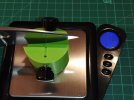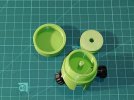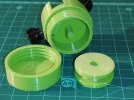You're just copying something and trying to make it look like a "great less expensive option to that over priced thing over there". I find your actions to be unethical.
Brian.
Hi Brian, perhaps you should read the second sentence in my first post again. I very clearly said this is based on the BESS Edge-On-Up sharpness tester. All recognition to them, I never said this is my invention or idea.
This is an experiment. I need a holder for various fishing lines, not BESS test media. The experiment here is to compare other test media types.
The actual Edge-on-up Aluminum Test Fixture that I based this DIY project design on is only a $35 part from Bess Edge on up. Their actual "tester" is the scale for the PT50A and B that they make and sell. How that scale operates, is where they did all the work and absolutely deserve recognition for it.
What I'm trying to do here, is see how inexpensive fishing line and a cheap digital scale compares as an experiment.
FYI, anyone can buy the $35 Aluminum Edge on Up Test Fixture and use it on a home kitchen scale to do exactly what I'm doing with mine, but you can't use fishing line in it. I want to experiment with fishing line in stead of the "official" test media and apparently it's not possible to do that with the Edge-on-up aluminum holder so I had to make something slightly different.
I don't have an "official" PT50A or B tester, nor do I have a Aluminum test media holder to "copy" so I can't actually tell what the internals of the holder is like at all. I can't imagine their internals working exactly the same as the one I made, because the BESS test media comes in a container, not a wind-able reel. Internally, mine is designed like a swappable fishing reel.
Yes, I absolutely made this DIY version look aesthetically similar so when an avid sharpener looks at it, they will know what exactly it is they are looking at.
It's a spool for fishing line in a tube with 2 screws holding the line in place over a gap to cut...it's not a new cancer therapy and it's not some evil villain's master plan to take business away from anyone. It's an experiment to learn more about push cut testing, using alternative media and a basic digital scale.
Interestingly, originally I considered making my holder square for better placement and alignment on my small scale, but then my threaded bottom cap and round fishing line spool would not work nor would anybody recognize it for what it is when they see it. A picture says more than words. The Edge on up holder doesn't close with a threaded cap, nor does it have an internal axis for a fishing line wind-able reel.
For anyone to make one of these holders themselves at home they would need to buy a 3D printer first, so unlikely in most cases. I have, and use a 3D printer and 3D designing software daily so it makes sense to make stuff for myself where I can, especially when experimenting with something.
The scale I use for my experimentation is a kitchen scale, not a PT50 Bess Edge on up scale "copy" nor anything even close to it, unless you think using a kitchen scale is copying what Edge on up does?
Edge on up use "official" test media, I use plain old fishing line. Is store bought fishing line also a "copy" of their test media?
Lastly, this is an openly shared and FREE design. A 3D printable or CNC machinable design downloadable in STL file format. There is no other design I could find to print for this experiment. I 3D modeled and printed one for myself and made it available for anyone else who would like to run the same experiment. Since when is openly sharing home made DIY projects for experimenting and information such an issue?
If you were to make yourself a pot hanger handle for your kitchen wall and you make it aesthetically match the Home Depot hand towel hanger attached to the wall next to it, would this be theft of a Home Depot hanger? How about being good at woodworking and making an extra kitchen cabinet door that looks like the IKEA ones in your kitchen. Making another one for yourself is theft?
Have you ever made yourself a new knife handle to match the other side scale that has broken off? Have you ever made a metal bracket with your milling machine to mount something on your Ford pick-up truck but made it match the Ford looks? Have you ever made any wooden chairs to visually match the other store bought chairs in your house? I guess not, that would be unethical, right?
This is a spool holder based on Edge On Up. I said that in my very first post. This whole exercise is an experiment for comparison. If the Edge on up holders could take normal fishing line in a small reel, then I'd love to experiment with it but apparently it can not. This is an experiment meant for sharpening nerds like myself, so see it for what it is.










